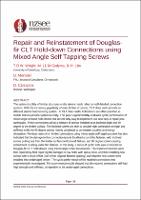| dc.contributor.author | Wright, Thomas | |
| dc.contributor.author | Li, Minghao | |
| dc.contributor.author | Lim, Thomas | |
| dc.contributor.author | Moroder, Daniel | |
| dc.contributor.author | Carradine, David | |
| dc.contributor.author | Gedyma, Mikhail | |
| dc.date.accessioned | 2023-02-21T01:18:11Z | |
| dc.date.available | 2023-02-21T01:18:11Z | |
| dc.date.issued | 2022-04-27 | |
| dc.identifier.uri | https://repo.nzsee.org.nz/xmlui/handle/nzsee/2477 | |
| dc.description.abstract | The system ductility of timber structures under seismic loads relies on well detailed connection systems. With the increasing popularity of mass timber structures, CLT shear walls provide an efficient seismic load resisting system. In CLT shear walls, hold-downs are often specified as ductile links to provide system ductility. This paper experimentally evaluates cyclic performance of mixed angle screwed hold-downs that are not only easy to implement, but also easy to repair post-earthquake. These connections utilise a mixture of screws installed at an inclined angle and 90-degree to the timber surface. The inclined screws are able to provide high connection strength and stiffness while the 90-degree screws mainly contribute to connection ductility and energy dissipation. Previous research on timber connections using mixed angle self-tapping screws has also indicated that the damage in this connection type is localised around the fastener, with inclined screws pulling out from the timber surface (withdrawal failure), and 90-degree screws causing embedment crushing under the fastener. In this study, a series of cyclic tests were conducted on Douglas-fir CLT hold-downs using mixed angle screw installations. The tested connections were then repaired by first repairing the damaged screw holes with epoxy resin, and then installing new screws with a small offset (half of the original fastener spacing) such that the new screws were installed into undamaged timber. The cyclic performance of the repaired connections was experimentally investigated. The experimental results showed that the repaired connections still had high strength and stiffness, comparable to the undamaged connections. | |
| dc.language.iso | en | |
| dc.publisher | New Zealand Society for Earthquake Engineering | |
| dc.relation.ispartofseries | 2022;34 | |
| dc.subject | Other topic related to earthquake engineering and its application | |
| dc.subject | Advancements in structural and geotechnical design and assessment | |
| dc.title | Repair and Reinstatement of Douglas-fir CLT Hold-down Connections using Mixed Angle Self Tapping Screws | |
| dc.type | Article | |

